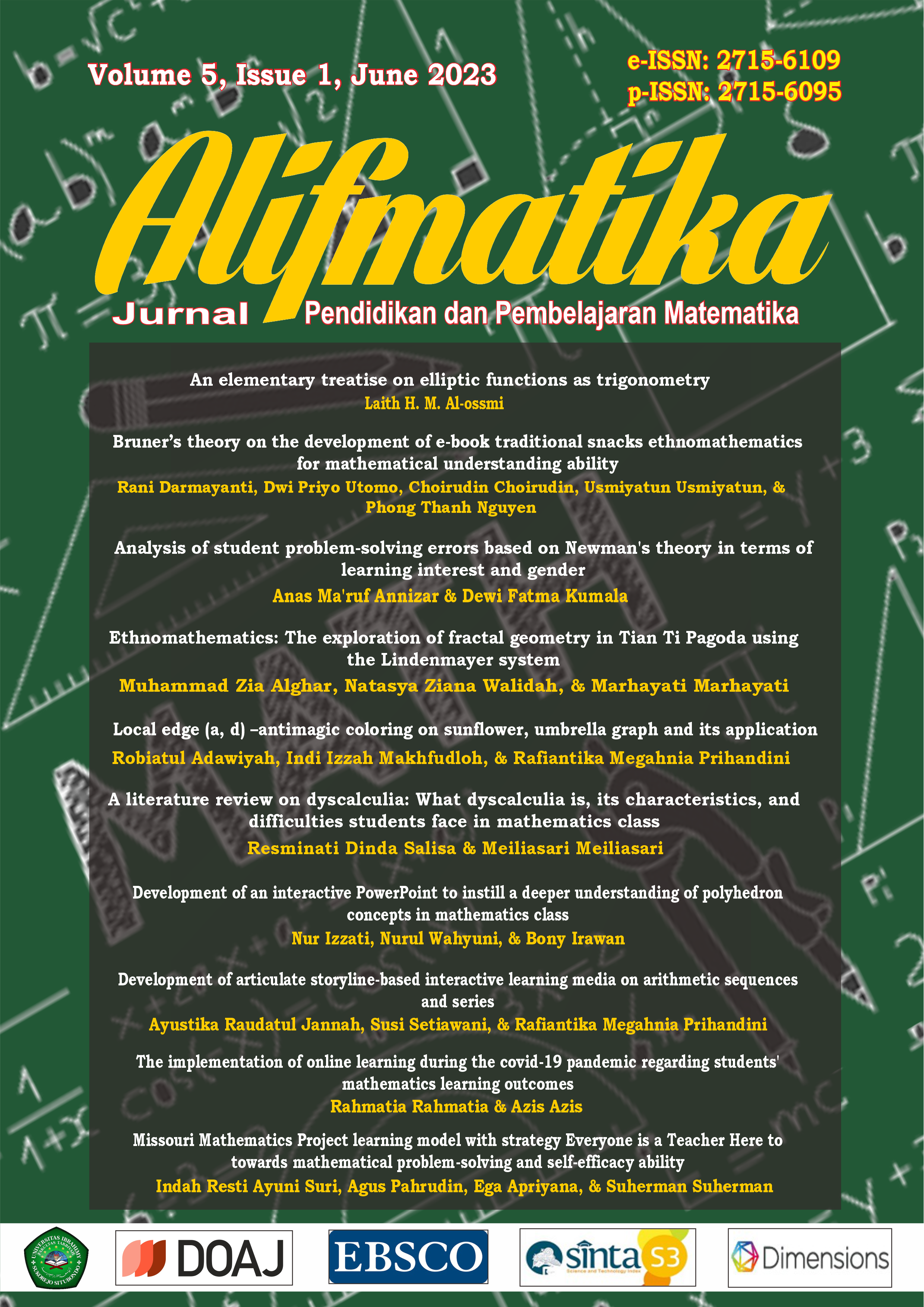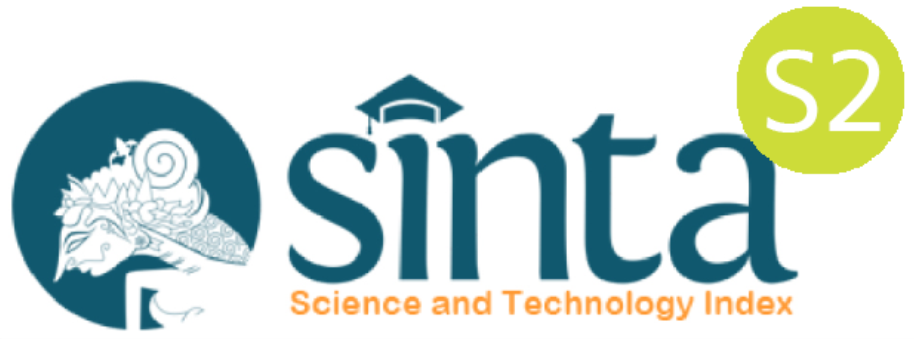A literature review on dyscalculia: What dyscalculia is, its characteristics, and difficulties students face in mathematics class
DOI:
https://doi.org/10.35316/alifmatika.2023.v5i1.82-94Keywords:
Characteristics, Difficulties, Dyscalculia, Mathematics Learning DisabilityAbstract
Dyscalculia is a specific learning condition that affects the comprehension and manipulation of numerical concepts, which can impact students' academic performance and well-being in mathematics education. The research methodology used was a systematic literature review that aimed to identify and synthesize the existing evidence regarding the differences in understanding of dyscalculia, its characteristics and the difficulties that students with dyscalculia may face in class. The search string used in electronic databases, such as Crossref and Google Scholar, to generate articles for the review were “dyscalculia” and “dyscalculia characteristics.” After the study selection process and appraising its quality, 23 articles met the selection criteria and were reviewed to synthesize answers to the research questions. The findings suggest despite many differences in understanding what dyscalculia was and it was clear that dyscalculia is a specific learning condition that affected students’ comprehension and manipulation of numerical concepts. Students with dyscalculia exhibit various characteristics, the most noticeable of which was low mathematics achievement scores. The difficulties faced by students with dyscalculia in the classroom were numerous. However, the primary obstacles they faced involved comprehending and applying mathematical concepts, as these difficulties could lead to others, such as executing mathematical problem-solving instructions. Educators might comprehend the diverse characteristics of dyscalculia to provide appropriate support and accommodations for students with difficulties.
Downloads
References
Ahuja, N. J., Thapliyal, M., Bisht, A., Stephan, T., Kannan, R., Al-Rakhami, M. S., & Mahmud, M. (2022). An investigative study on the effects of pedagogical agents on intrinsic, extraneous and germane cognitive load: experimental findings with dyscalculia and non-dyscalculia learners. IEEE Access, 10, 3904–3922. https://doi.org/10.1109/ACCESS.2021.3115409
Aisyah, A., & Juandi, D. (2022). The description of Indonesian student mathematics literacy in the last decade. International Journal of Trends in Mathematics Education Research, 5(1), 105–110. https://doi.org/10.33122/ijtmer.v5i1.114
Aprinastuti, C., Anggadewi, B. E. T., Suharno, R., & Wiyantari, W. (2020). Development of mathematics manipulative for slow learner and dyscalculia student in elementary school by using Montessori’s characteristic. Journal of Physics: Conference Series, 1663(1), 012065. https://doi.org/10.1088/1742-6596/1663/1/012065
Bulthé, J., Prinsen, J., Vanderauwera, J., Duyck, S., Daniels, N., Gillebert, C. R., Mantini, D., Op de Beeck, H. P., & De Smedt, B. (2019). Multi-method brain imaging reveals impaired representations of number as well as altered connectivity in adults with dyscalculia. NeuroImage, 190, 289–302. https://doi.org/10.1016/j.neuroimage.2018.06.012
Cheng, D., Xiao, Q., Cui, J., Chen, C., Zeng, J., Chen, Q., & Zhou, X. (2020). Short‐term numerosity training promotes symbolic arithmetic in children with developmental dyscalculia: The mediating role of visual form perception. Developmental Science, 23(4). https://doi.org/10.1111/desc.12910
Dehghani, H. (2019). The effectiveness of a mobile application “Kalcal” on the learning of mathematics in students with dyscalculia. 2019 International Serious Games Symposium (ISGS), 1–6. https://doi.org/10.1109/ISGS49501.2019.9047035
Ernest, P. (2018). The ethics of mathematics: is mathematics harmful? (pp. 187–216). https://doi.org/10.1007/978-3-319-77760-3_12
Fauzan, A., Andita, C. D., Rada, G., Zafirah, A., & Abdullah, A. H. Bin. (2022). Developing RME-based learning trajectory for teaching addition to a dyscalculia student in elementary school. Jurnal Didaktik Matematika, 9(1), 39–58. https://doi.org/10.24815/jdm.v9i1.25340
Firmasari, S., Herman, T., & Kusuma Dewi, I. L. (2021). Dyscalculia: Mathematical difficulties in the concept of multiplication using word problems. Jurnal Inspirasi Pendidikan, 11(2), 113–121. https://doi.org/10.21067/jip.v11i2.5852
Grigore, M. (2020). Towards a standard diagnostic tool for dyscalculia in school children. CORE Proceedings, 1(1). https://doi.org/https://doi.org/10.21428/bfdb1df5.d4be3454
Gut, M., Goraczewski, Ł., Finc, K., Matulewski, J., Walerzak-Więckowska, A., & Duch, W. (2021). Number line estimation strategies used by children with dyscalculia and typically developing controls. Przegląd Psychologiczny, 64(3). https://doi.org/10.31648/pp.7330
Jannah, T. M., & Bharata, H. (2020). The analysis of dyscalculia that referred to the learning style of fleming and mills theory on matrix materials of MAN 1 Metro students. Journal of Physics: Conference Series, 1563(1), 012068. https://doi.org/10.1088/1742-6596/1563/1/012068
Kariyawasam, R., Nadeeshani, M., Hamid, T., Subasinghe, I., & Ratnayake, P. (2019). A gamified approach for screening and intervention of dyslexia, dysgraphia and dyscalculia. 2019 International Conference on Advancements in Computing (ICAC), 156–161. https://doi.org/10.1109/ICAC49085.2019.9103336
Kißler, C., Schwenk, C., & Kuhn, J.-T. (2021). Two dyscalculia subtypes with similar, low comorbidity profiles: A mixture model analysis. Frontiers in Psychology, 12. https://doi.org/10.3389/fpsyg.2021.589506
Kunwar, R., & Sharma, L. (2020). Exploring teachers’ knowledge and students’ status about dyscalculia at basic level students in Nepal. Eurasia Journal of Mathematics, Science and Technology Education, 16(12), em1906. https://doi.org/10.29333/ejmste/8940
Lazo-Amado, M., Cueva-Ruiz, L., & Andrade-Arenas, L. (2022). Prototyping a mobile application for children with dyscalculia in primary education using augmented reality. International Journal of Advanced Computer Science and Applications, 13(10). https://doi.org/10.14569/IJACSA.2022.0131085
Lewis, K. E., Sweeney, G., Thompson, G. M., Adler, R. M., & Alhamad, K. (2022). Dyscalculia in algebra: A case study. Insights into Learning Disabilities, 19(1), 3–36. https://files.eric.ed.gov/fulltext/EJ1341307.pdf
Lewis, K. E., Thompson, G. M., & Tov, S. A. (2022). Screening for characteristics of dyscalculia: Identifying unconventional fraction understandings. Lnternational Electronic Journal of Elementary Education. https://doi.org/10.26822/iejee.2022.242
Liu, S., Cheng, C., Wu, P., Zhang, L., Wang, Z., Wei, W., Chen, Y., & Zhao, J. (2022). Phonological processing, visuospatial skills, and pattern understanding in chinese developmental dyscalculia. Journal of Learning Disabilities, 55(6), 499–512. https://doi.org/10.1177/00222194211063650
Mariera, N. M., Murugami, M., & Muthee, J. (2021). Mathematics efficacy among students with dyscalculia in public high schools in kandara sub-county, muranga county, kenya. European Journal of Education Studies, 8(7). https://doi.org/10.46827/ejes.v8i7.3828
N. Onyishi, C., & M. Sefotho, M. (2021). Differentiating instruction for learners’ mathematics self-efficacy in inclusive classrooms: Can learners with dyscalculia also benefit? South African Journal of Education, 41(4), 1–15. https://doi.org/10.15700/saje.v41n4a1938
Newman, M., & Gough, D. (2020). Systematic reviews in educational research: Methodology, perspectives and application. In Systematic Reviews in Educational Research (pp. 3–22). Springer Fachmedien Wiesbaden. https://doi.org/10.1007/978-3-658-27602-7_1
Noordin, M. S. S., Mohd Bahrin, U. F., Hamzah, S. S., & Sa’dan, S. ‘Aisyah. (2020). Mathematics courseware for dyscalculia students (MCDYs). E-Academia Journal, 9(2). https://doi.org/10.24191/e-aj.v9i2.11519
Patricia, F. A., & Zamzam, K. F. (2021). Development of scientific approach-based interactive multimedia for elementary school dyscalculia children. Jurnal Prima Edukasia, 9(1). https://doi.org/10.21831/jpe.v9i1.33853
Purwaningrum, J. P., Muzid, S., Siswono, T. Y. E., & Masriyah, M. (2021). Local wisdom-oriented learning module to improve mathematical creative thinking ability of dyscalculia students. Linguistics and Culture Review, 5(S2), 1035–1044. https://doi.org/10.21744/lingcure.v5nS2.1618
Putri Purwaningrum, J., Nur Ahyani, L., & Prasetyo Utomo, A. (2022). The need for a digital module to improve the numerical literacy of dyscalculia students. Kalamatika: Jurnal Pendidikan Matematika, 7(1), 99–110. https://doi.org/10.22236/KALAMATIKA.vol7no1.2022pp99-110
Vigna, G., Ghidoni, E., Burgio, F., Danesin, L., Angelini, D., Benavides-Varela, S., & Semenza, C. (2022). Dyscalculia in early adulthood: Implications for numerical activities of daily living. Brain Sciences, 12(3), 373. https://doi.org/10.3390/brainsci12030373
Ziadat, A. H. (2022). Sketchnote and working memory to improve mathematical word problem solving among children with dyscalculia. International Journal of Instruction, 15(1), 509–526. https://doi.org/10.29333/iji.2022.15129a
Downloads
Published
How to Cite
Issue
Section
License
COPYRIGHT NOTICE
Author (s) who publish in Alifmatika: Jurnal Pendidikan dan Pembelajaran Matematika agree to the following terms:
- The Author (s) submitting a manuscript do so on the understanding that if accepted for publication, copyright of the article shall be assigned to Alifmatika: Jurnal Pendidikan dan Pembelajaran Matematika, Tarbiyah Faculty of Ibrahimy University as the publisher of the journal. Consecutively, author(s) still retain some rights to use and share their own published articles without written permission from Alifmatika: Jurnal Pendidikan dan Pembelajaran Matematika. This work is licensed under a Creative Commons Attribution-ShareAlike 4.0 International License.
- Copyright encompasses rights to publish and provide the manuscripts in all forms and media for the purpose of publication and dissemination, and the authority to enforce the rights in the manuscript, for example in the case of plagiarism or in copyright infringement.
- Alifmatika: Jurnal Pendidikan dan Pembelajaran Matematika and the Editors make every effort to ensure that no wrong or misleading data, opinions or statements be published in the journal. In any way, the contents of the articles and advertisements published in Alifmatika: Jurnal Pendidikan dan Pembelajaran Matematika are the sole responsibility of their respective authors and advertisers.
- The Copyright Transfer Form can be downloaded here [Copyright Transfer Form Alifmatika]. The copyright form should be signed originally and send to the Editorial Office in the form of original mail, scanned document to alifmatika[at]ibrahimy.ac.id or upload the scanned document in the comments column when sending the manuscript.























_by_Matematohir.jpg)






